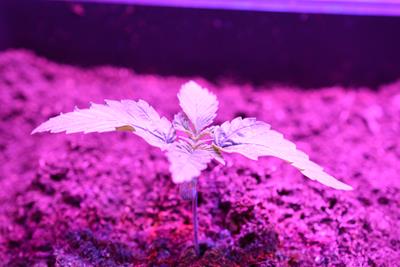
Wednesday December 7, 2016
 Growing
Growing
When it comes to cannabis, organic growing and incorporating highly natural processes are on the rise. That’s why no-till growing is so popular, and a key aspect of the organic cannabis movement. No-till growing is the process of farming that focuses on as minimal manual soil disturbance as possible. This process allows for maximized water content and organic matter retention – leading to high-quality cannabis with sustainable practices.
What Exactly is No-Till Farming?
No-till farming (also known as zero tillage or direct drilling) is the process of growing crops without disturbing the soil through tillage (mechanical agitation of soil such as digging, stirring and overturning). The no-tilling technique increases both water absorption and organic matter retention by recycling nutrients back into the soil.
Specifically, in the regular tilling process, a plow agitates (flips over) layers of soil. The purpose of tilling (agitating the soil) is to break up old soil, prepare the soil for seeds, or even to remove weeds. Essentially, tilling manually forces turnover of soil, “refreshing” it if you will.
But the difference with a no-tilling practice is that it relies on its own natural processes to refresh the soil. No-till farming does not require mechanical agitation. Rather, it depends on its own organic matter (good bacteria, beneficial fungi, and living organisms) to self-maintain so that the soil can be used over and over again for years.
There are many benefits to the no-till process but the most powerful benefit of all is that it makes soil more resilient. This leads to more efficient farming, improved sowing time, and less waste. And for the health-conscious cannabis consumers, a more natural and organic product they can more guiltlessly consume.
How is No-Till Farming Used?
While no-till farming can be used on a large agricultural scale, it’s also a practice and philosophy that can be applied indoors for home cannabis growing as well. By reusing the soil season after season, regardless of farming scale, growers can save time and money on buying new soil and nutrients while still reaping the benefits of organic, natural cannabis.
When enjoying organic, no-till farmed pot, you can rest-assured that the product tastes and performs the way nature intended. Even better, you know what you’re putting into your body at all times. Additionally, no-till growing helps preserve the environment by supporting more sustainable practices. No-till growers are part of a rising demographic that is progressing the organic movement and changing the industry for the better – holding it to more accountability and social responsibility than ever before.
Why is No-Till Farming Popular?
Reusing soil without tilling it or mixing it between uses allows the gardener to take full advantage of the beneficial fungi, microbes, and organic life (e.g. –worms). The soil is stronger, more resilient and does not require chemicals, making for an organic process and end product. This is important because we want to know what we’re putting inside our bodies – be it pot, food or drinks.
The organic lifestyle is gaining monumental popularity thanks to food and farming education. The world is leaning towards more natural practices in all industries, demanding big pharma, corporations and mass farming to exercise local, organic and sustainable philosophies. And now that recreational cannabis is legalizing at a rapid rate, it only makes sense that the demands of the consumers will affect supply and manufacturing practices.
The days of stoners smoking mystery bud in their basements is long gone. Today’s cannabis consumer is educated, health-conscious, and wide-ranging. While no two tokers are alike, there is a growing movement for more health-focused pot products. Customers want cannabis that hasn’t been leached with chemicals, without a heavy carbon footprint and without mysterious ingredients and/or manufacturing practices.
The no-till farming practice is a solution to these needs. By reusing soil season after season, this process is sustainable. By encouraging its own organic matter growth, the soil becomes its own self-sustaining ecosystem, eliminating the need for chemicals and/or added nutrients. Because of these no-till advantages, it’s easy to see why the savvy cannabis-consumer is progressing towards the no-till movement and making it a growing trend within the cannabis industry.
Photo Credit: Cannabis Pictures








